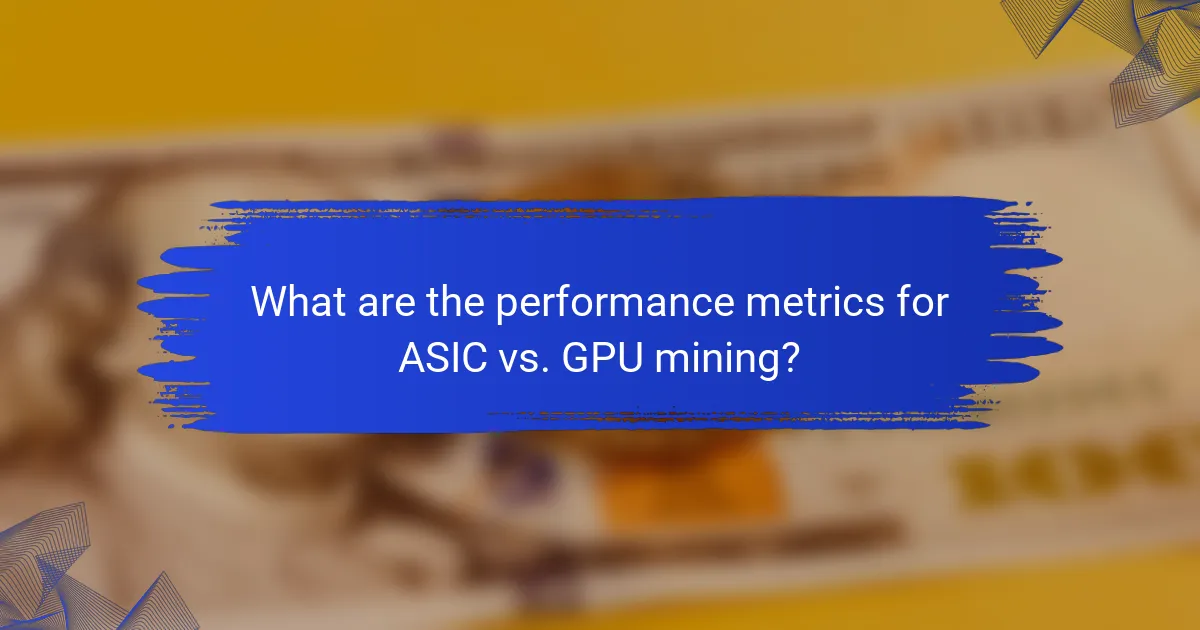ASIC mining involves the use of Application-Specific Integrated Circuits tailored for cryptocurrency mining, delivering high efficiency and performance for specific algorithms. In contrast, GPU mining utilizes Graphics Processing Units, offering versatility for mining various cryptocurrencies but generally with lower efficiency. This article analyzes the performance metrics, cost-effectiveness, and use cases of both mining methods, highlighting key differences in hash rates, energy consumption, and overall profitability. It discusses how ASIC miners, while requiring a higher initial investment, often yield better returns over time, particularly for cryptocurrencies like Bitcoin, whereas GPUs provide adaptability for changing market conditions. The choice between ASIC and GPU mining ultimately hinges on factors such as cost, energy efficiency, and the specific cryptocurrency being targeted.

What are ASIC and GPU Mining?
ASIC mining refers to the use of Application-Specific Integrated Circuits designed specifically for mining cryptocurrencies. These devices are optimized for a single task, providing high efficiency and performance. GPU mining, on the other hand, utilizes Graphics Processing Units that are more versatile and can mine various cryptocurrencies. GPUs are commonly used in gaming and can be repurposed for mining activities. ASIC miners generally offer higher hash rates than GPUs, making them more effective for certain cryptocurrencies. However, GPUs provide flexibility in mining different coins and can be more accessible for hobbyists. The choice between ASIC and GPU mining often depends on factors like cost, electricity consumption, and the specific cryptocurrency being mined.
How do ASIC miners differ from GPU miners?
ASIC miners are specialized hardware designed solely for cryptocurrency mining, while GPU miners utilize graphics processing units for a broader range of computational tasks. ASIC miners offer higher efficiency and performance for specific algorithms, leading to faster mining speeds. For example, an ASIC miner can achieve hash rates of over 100 TH/s, significantly outperforming a typical GPU miner, which may reach around 30 MH/s for Ethereum mining. ASIC miners consume less power per hash compared to GPU miners, making them more cost-effective in terms of electricity usage. However, GPU miners are versatile and can mine various cryptocurrencies, adapting to different algorithms. This flexibility allows GPU miners to remain relevant even when specific coins become less profitable for ASICs. The choice between ASIC and GPU mining ultimately depends on the specific cryptocurrency being mined and the miner’s goals.
What are the key characteristics of ASIC miners?
ASIC miners are specialized hardware designed for cryptocurrency mining. They offer high efficiency and performance compared to general-purpose hardware. ASIC miners are optimized for specific hashing algorithms, making them faster and more energy-efficient. They typically have a higher hash rate, which translates to increased mining rewards. The power consumption of ASIC miners is generally lower per unit of hash rate compared to GPUs. ASIC miners are less versatile, as they cannot be reprogrammed for different algorithms. This specialization limits their use to specific cryptocurrencies. The initial cost of ASIC miners can be significant, but their operational efficiency often justifies the investment.
What are the key characteristics of GPU miners?
GPU miners are specialized hardware designed for cryptocurrency mining using Graphics Processing Units. They excel in parallel processing capabilities, allowing simultaneous calculations for mining algorithms. GPU miners support a wide range of cryptocurrencies, making them versatile. They are generally more accessible and cost-effective compared to ASIC miners. The power consumption of GPU miners varies, typically ranging from 200 to 300 watts per unit. Additionally, they provide a higher degree of flexibility in terms of software and algorithm adaptability. The resale value of GPU miners tends to be better than ASICs, as they can also be used for gaming and other tasks. Overall, GPU miners are favored for their balance of performance, cost, and adaptability in the mining landscape.
What are the primary uses of ASIC and GPU mining?
ASIC mining is primarily used for cryptocurrency mining, particularly for Bitcoin. ASICs are designed for specific algorithms, making them highly efficient. They outperform GPUs in terms of hash rate and energy consumption for Bitcoin mining.
GPU mining is versatile and supports multiple cryptocurrencies. GPUs can mine coins like Ethereum, Monero, and Zcash. They offer flexibility in mining various algorithms. Additionally, GPUs are suitable for gaming and rendering tasks, providing dual functionality.
In summary, ASICs excel in dedicated cryptocurrency mining, while GPUs offer broader applications across different cryptocurrencies and other computing tasks.
In which scenarios is ASIC mining preferred?
ASIC mining is preferred in scenarios requiring maximum efficiency and high hash rates. These specialized devices outperform general-purpose hardware like GPUs in computational power. ASIC miners are ideal for established cryptocurrencies like Bitcoin, where competition is intense. Their design focuses on specific algorithms, leading to lower energy consumption per hash. This efficiency translates to higher profitability in mining operations. Furthermore, ASICs are advantageous when mining pools are involved, as they increase the chances of earning rewards. The initial investment is typically higher, but the long-term returns can justify the cost. Overall, ASIC mining excels in environments prioritizing speed, efficiency, and profitability.
In which scenarios is GPU mining preferred?
GPU mining is preferred in scenarios where flexibility and versatility are required. It is effective for mining multiple cryptocurrencies that utilize different algorithms. GPU mining is also advantageous for individuals who want to mine at home, as it allows for easier setup and maintenance compared to ASIC miners. Furthermore, GPU rigs can be upgraded over time, enhancing their performance and adaptability. This flexibility makes GPU mining suitable for hobbyists and small-scale miners. Additionally, in markets with fluctuating cryptocurrency values, the ability to switch between coins can maximize profitability. Overall, GPU mining is favored for its adaptability, accessibility, and potential for diversified mining strategies.

What are the performance metrics for ASIC vs. GPU mining?
ASIC mining generally offers higher performance metrics compared to GPU mining. ASIC miners are specifically designed for particular algorithms, resulting in superior hash rates. For example, an Antminer S19 Pro can achieve a hash rate of around 110 TH/s. In contrast, a high-end GPU, like the Nvidia RTX 3090, typically achieves around 100 MH/s for Ethereum mining.
Energy efficiency is another critical performance metric. ASIC miners generally consume less power per unit of hash rate. The Antminer S19 Pro has a power consumption of about 3250W, yielding a power efficiency of approximately 29.5 J/TH. On the other hand, the RTX 3090 consumes around 350W, resulting in a power efficiency of about 3.5 J/MH.
In terms of cost, ASIC miners tend to have a higher upfront investment but can provide better returns over time due to their efficiency. GPUs are more versatile and can mine various cryptocurrencies, but they often have lower performance metrics for specific coins.
Overall, ASIC mining is more efficient for dedicated tasks, while GPU mining offers flexibility across different algorithms.
How do hash rates compare between ASIC and GPU mining?
ASIC mining generally offers higher hash rates compared to GPU mining. ASIC miners are specifically designed for cryptocurrency mining, optimizing performance for specific algorithms. They can achieve hash rates exceeding 100 TH/s for Bitcoin mining. In contrast, high-end GPUs typically reach hash rates around 30 MH/s for Ethereum mining. The efficiency disparity is significant. ASICs are purpose-built, while GPUs are versatile but less efficient for mining. This efficiency leads to higher profitability for ASIC miners in many scenarios.
What factors influence hash rates in ASIC mining?
Hash rates in ASIC mining are influenced by several key factors. The design and architecture of the ASIC chip play a significant role. More efficient designs can process more hashes per second. The manufacturing process also affects performance. Higher quality components lead to better hash rates. Power supply efficiency is crucial as well. ASIC miners require substantial energy to operate effectively. Cooling systems impact hash rates too. Overheating can reduce performance and efficiency. Finally, network difficulty affects hash rates. As more miners join the network, it becomes harder to mine, impacting hash performance.
What factors influence hash rates in GPU mining?
Hash rates in GPU mining are influenced by several key factors. The primary factor is the GPU’s processing power, measured in teraflops. Higher teraflops generally lead to increased hash rates. Another factor is the GPU’s architecture, which affects efficiency and performance. Cooling solutions also play a role; effective cooling can enhance performance and stability. Power consumption is significant as well; GPUs that use less power while maintaining high performance yield better profitability. Additionally, the mining algorithm used impacts hash rates, as some algorithms are more suited to specific GPU architectures. Lastly, driver updates and software optimization can improve hash rates by enhancing the GPU’s performance capabilities.
What is the energy efficiency of ASIC vs. GPU mining?
ASIC mining is significantly more energy efficient than GPU mining. ASICs are designed specifically for cryptocurrency mining, optimizing power consumption for their intended tasks. For instance, ASIC miners can achieve energy efficiencies of around 0.05 J/GH, while GPUs typically operate at about 1.5 J/GH or higher. This means ASICs use far less electricity to perform the same amount of hashing. The specialized nature of ASICs allows them to outperform GPUs in energy efficiency.
How is energy consumption measured in ASIC mining?
Energy consumption in ASIC mining is measured using wattage. This is quantified by assessing the power draw of the ASIC miner during operation. The measurement is often expressed in watts (W) or kilowatts (kW). To determine total energy consumption, the wattage is multiplied by the time of operation in hours. For example, if an ASIC miner consumes 1500W and operates for 24 hours, the total energy consumption is 36 kWh. This calculation helps miners evaluate operational costs and efficiency. Monitoring tools and software can provide real-time data on energy usage for precise tracking.
How is energy consumption measured in GPU mining?
Energy consumption in GPU mining is measured in watts (W) or kilowatts (kW). This measurement quantifies the electrical power used by the GPU during mining operations. Tools like watt meters or software applications can monitor real-time power usage. These tools provide data on the energy consumed over specific periods. For example, a mining rig running at 300W continuously for 24 hours consumes 7.2 kWh of energy. This consumption directly impacts mining profitability by affecting operational costs. Accurate energy measurement is essential for optimizing mining efficiency and cost management.

What is the cost-effectiveness of ASIC vs. GPU mining?
ASIC mining is generally more cost-effective than GPU mining for cryptocurrency mining. ASIC miners are specifically designed for mining and offer higher hash rates at lower energy consumption. This results in a greater return on investment over time. In contrast, GPU mining is more versatile but often incurs higher operational costs due to lower efficiency and higher power usage. According to a study by Coin Metrics, ASIC miners can achieve a cost per hash that is significantly lower than GPUs, making them a preferred choice for large-scale mining operations. The upfront cost of ASICs is higher, but the long-term savings and profitability often outweigh this initial investment.
What are the initial investment costs for ASIC and GPU mining?
Initial investment costs for ASIC mining typically range from $2,000 to $10,000 per unit. This price depends on the specific model and its hashing power. ASIC miners are designed for specific cryptocurrencies, which influences their cost. In contrast, GPU mining setups can cost between $1,000 and $5,000. This cost varies based on the number of graphics cards and the overall rig configuration. GPUs offer more versatility, allowing mining of different cryptocurrencies. Both mining types also require additional expenses for power supply units, cooling systems, and motherboards. Therefore, total initial costs can escalate based on the chosen setup and components.
What are the costs associated with ASIC mining equipment?
The costs associated with ASIC mining equipment include the purchase price, electricity consumption, and maintenance expenses. The purchase price for ASIC miners typically ranges from $1,000 to $10,000, depending on the model and hashing power. Electricity consumption can cost between $0.05 to $0.15 per kWh, significantly impacting overall profitability. Maintenance expenses may include cooling systems and repair costs, averaging around 5% of the initial investment annually. Additionally, shipping and import taxes can add to the overall cost. These factors collectively determine the total financial commitment required for ASIC mining operations.
What are the costs associated with GPU mining equipment?
The costs associated with GPU mining equipment include the initial purchase price, electricity costs, and maintenance expenses. The initial purchase price for a GPU can range from $200 to over $1,500, depending on the model and performance. Electricity costs can vary significantly based on local rates, often ranging from $0.10 to $0.30 per kWh. A mining rig typically consumes between 300 to 1,200 watts. Maintenance expenses may include cooling solutions, replacement parts, and potential repairs. Overall, the total cost of ownership can exceed several thousand dollars when factoring in all these elements.
How do operational costs compare for ASIC and GPU mining?
ASIC mining generally has lower operational costs compared to GPU mining. ASIC miners are specifically designed for cryptocurrency mining, which allows them to operate more efficiently. They consume less power per unit of hashing power. For example, an ASIC miner can provide up to 100 TH/s while consuming around 3250W. In contrast, a typical GPU mining rig may achieve only 30 MH/s with a power consumption of 1200W per GPU.
This difference means that ASIC miners can achieve a higher return on investment due to lower electricity costs. Additionally, ASIC miners tend to have a longer lifespan for mining specific cryptocurrencies. Overall, the efficiency of ASIC mining results in reduced operational costs when compared to GPU mining.
What are the ongoing maintenance costs for ASIC miners?
Ongoing maintenance costs for ASIC miners typically include electricity, cooling, and repair expenses. Electricity costs depend on the miner’s power consumption and local electricity rates. For example, an ASIC miner consuming 1500 watts running 24/7 can incur monthly electricity costs around $100 to $150. Cooling is essential to prevent overheating and can add another $50 to $100 monthly, depending on the setup. Repair costs vary based on equipment age and issues but can average $20 to $50 monthly. Overall, ongoing maintenance costs can range from $170 to $300 per month.
What are the ongoing maintenance costs for GPU miners?
Ongoing maintenance costs for GPU miners typically include electricity, cooling, hardware upkeep, and software updates. Electricity costs can range from $0.10 to $0.30 per kWh, depending on location and usage. Cooling systems are essential to prevent overheating, with costs for fans and air conditioning varying widely. Hardware upkeep may involve replacing worn-out components, which can add up to several hundred dollars annually. Software updates are necessary for optimal performance and security, often requiring periodic investment in management tools. Overall, these costs can sum to hundreds or even thousands of dollars per year, depending on the scale of the mining operation.

What are the real-world use cases for ASIC and GPU mining?
ASIC mining is primarily used for mining cryptocurrencies such as Bitcoin. It offers high efficiency and performance due to its specialized design. ASIC miners are optimized for specific algorithms, resulting in faster processing speeds. This leads to higher hash rates compared to general-purpose hardware.
GPU mining, on the other hand, is versatile and can mine various cryptocurrencies. It is commonly used for mining Ethereum and other altcoins. GPUs are more adaptable and can be repurposed for different algorithms. This flexibility allows miners to switch to more profitable cryptocurrencies as market conditions change.
Both ASIC and GPU mining serve the purpose of securing blockchain networks and validating transactions. They also enable miners to earn rewards in the form of cryptocurrency. The choice between ASIC and GPU mining often depends on factors like cost, energy efficiency, and the specific cryptocurrency being targeted.
Which cryptocurrencies are best mined with ASICs?
Bitcoin, Bitcoin Cash, and Litecoin are the cryptocurrencies best mined with ASICs. ASICs, or Application-Specific Integrated Circuits, are designed for specific tasks. They provide higher efficiency and hash rates compared to general-purpose hardware. Bitcoin mining requires significant computational power, making ASICs the optimal choice. Bitcoin Cash also benefits from ASIC mining due to its similar algorithm. Litecoin uses the Scrypt algorithm, which is efficiently mined using ASICs as well. The dominance of ASICs in these cryptocurrencies is evident in their network hash rates. For instance, Bitcoin’s network hash rate exceeds 200 EH/s, showcasing ASICs’ effectiveness.
What are the benefits of mining Bitcoin with ASICs?
Mining Bitcoin with ASICs offers significant advantages over other methods. ASICs, or Application-Specific Integrated Circuits, are designed specifically for Bitcoin mining. This specialization allows them to achieve higher hash rates compared to general-purpose hardware like GPUs.
Higher hash rates lead to increased chances of successfully mining blocks. ASIC miners also tend to be more energy-efficient, reducing electricity costs per hash. Studies show that ASICs can consume less power while providing more computational power.
Moreover, ASICs often have a longer operational lifespan due to their robust design. This longevity contributes to better return on investment over time. In summary, mining Bitcoin with ASICs provides higher efficiency, reduced energy costs, and improved profitability.
What are the drawbacks of mining Bitcoin with ASICs?
Mining Bitcoin with ASICs has several drawbacks. First, ASICs are highly specialized hardware. This means they cannot be repurposed for other tasks. Their initial cost is often high, leading to significant upfront investment. ASIC mining also results in increased energy consumption. This raises operational costs and contributes to environmental concerns. Additionally, ASICs can become obsolete quickly. As technology advances, newer models may outperform existing ones. Lastly, ASIC mining can lead to centralization of mining power. This undermines the decentralized nature of Bitcoin.
Which cryptocurrencies are best mined with GPUs?
Ethereum, Ravencoin, and Monero are among the best cryptocurrencies mined with GPUs. Ethereum utilizes the Ethash algorithm, which is memory-intensive and favors GPU mining. Ravencoin also employs a memory-hard algorithm called KawPow, making it suitable for GPU miners. Monero, known for its focus on privacy, uses the RandomX algorithm, optimized for CPU and GPU mining. These cryptocurrencies benefit from the parallel processing capability of GPUs. Mining profitability varies based on factors like electricity costs and network difficulty. Current market trends indicate a strong interest in GPU mining for these cryptocurrencies.
What are the benefits of mining Ethereum with GPUs?
Mining Ethereum with GPUs offers several benefits. GPUs provide higher hash rates compared to CPUs. This leads to increased efficiency in solving complex mathematical problems. Additionally, GPUs are more versatile and can mine various cryptocurrencies. They also have a lower initial investment compared to ASIC miners. The flexibility allows miners to switch between different coins based on profitability. Furthermore, GPUs typically have a longer lifespan and better resale value. This adaptability and longevity make GPU mining a popular choice among miners.
What are the drawbacks of mining Ethereum with GPUs?
Mining Ethereum with GPUs has several drawbacks. GPUs are less efficient than ASICs, leading to lower hash rates. This results in decreased profitability for miners. Additionally, GPUs consume significant amounts of electricity, increasing operational costs. The high energy consumption can lead to environmental concerns. Furthermore, GPU mining generates substantial heat, necessitating cooling solutions. This can further add to expenses. Lastly, as Ethereum transitions to proof of stake, GPU mining may become obsolete. These factors collectively make GPU mining less appealing compared to alternatives.
What are the best practices for choosing between ASIC and GPU mining?
When choosing between ASIC and GPU mining, consider the specific cryptocurrency you intend to mine. ASIC miners are designed for specific algorithms, offering higher efficiency and performance for those coins. In contrast, GPU mining is more versatile, allowing for mining of a variety of cryptocurrencies. Assess the initial investment cost; ASICs typically have higher upfront costs but better performance. Evaluate electricity consumption; ASICs usually consume less power for the same output compared to GPUs. Consider the mining difficulty and market conditions; ASICs may become obsolete faster if the coin’s algorithm changes. Research community support and software compatibility for both mining types. Finally, analyze your long-term goals; if you plan to diversify your mining activities, GPUs may provide more flexibility.
The main entity of the article is the comparison between ASIC and GPU mining in cryptocurrency mining. The article provides a detailed analysis of the performance metrics, cost-effectiveness, and use cases for both ASIC and GPU mining. It outlines the key characteristics of each mining type, including their efficiency, hash rates, and energy consumption, while also discussing the initial investment costs and ongoing maintenance expenses. Additionally, the article highlights the specific cryptocurrencies best suited for each mining method and offers guidance on choosing between ASIC and GPU mining based on individual goals and market conditions.